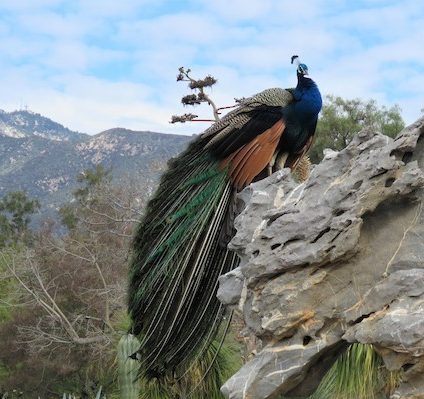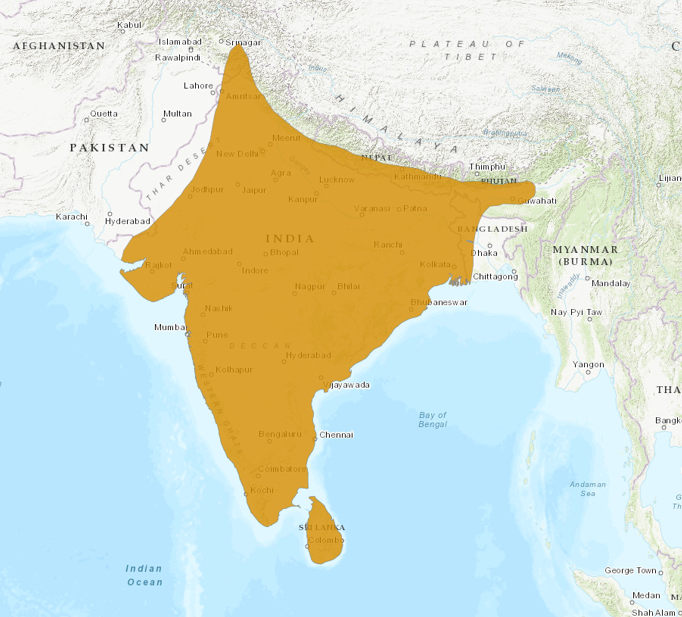Birdfinding.info ⇒ The living symbol of vanity is common across much of its native range in India, Nepal, Bhutan, and Sri Lanka. It seems to be especially numerous in the shadow of the Himalayas, and in north-central, western, and southern India, and on Sri Lanka. In the U.S. introduced populations are stable or expanding in: Los Angeles (especially Pasadena, Palos Verdes, and Irvine Regional Park); many areas of Florida (including Fort George Island, St. Petersburg, Lake Apopka, Canaveral, Fort Pierce, Key Biscayne, South Miami, Homestead); Oahu (e.g., Malaekahana State Recreation Area and Waimea Valley); Maui (e.g., Waihe’e Refuge and Garden of Eden Arboretum); and the Big Island (e.g., Makalei Golf Club and Pu’u Wa’awa’a).
Indian Peafowl
Pavo cristatus
Indian subcontinent, where it occurs in open woodlands, savannas, and mixed habitats, including settled and agricultural areas, from sea level up to about 2,000 m elevation.
Occurs nearly throughout India, from the southern slopes of the Himalayas south to Sri Lanka, west locally into eastern Pakistan, and east to Bhutan and western Assam—but apparently extirpated from Bangladesh.
Worldwide introductions have led to dozens of feral or semi-feral flocks, including some that roam free on the grounds of zoos, as well as city parks, estates, and institutional campuses on all continents except Antarctica.
A smaller number of truly wild-living, self-sustaining populations are established in: Singapore; the Ryukyu Islands (Ishigaki and Kuroshima); Australia (mainly eastern coastal lowlands from Queensland to Victoria); New Caledonia; New Zealand (North Island and eastern lowlands of South Island); the main Hawaiian Islands; California (around Los Angeles and north of San Francisco); and Florida (from Jacksonville south to the Keys).
Identification
Male is among the most spectacular of birds: turkey-sized, with a sapphire-blue head, neck, and underparts, largely golden-green upperparts, and an extravagant tail that approaches 2 meters long.
Its famously luxuriant tail (actually extended uppertail coverts) is thickly covered in long moss-green filaments and blue-and-coppery “eye-spots.” When displaying, the male fans the tail and holds it vertical—in the fashion for which peacocks are known.
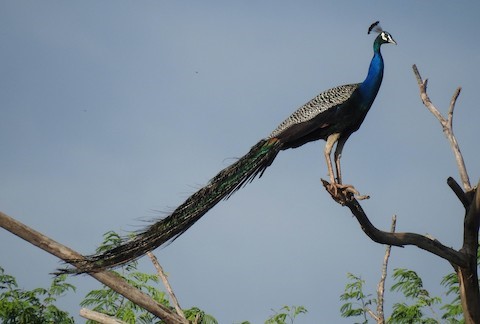
Indian Peafowl, male. (Hosakere, Doora, Mysore, Karnataka, India; June 14, 2019.) © Sahana M.
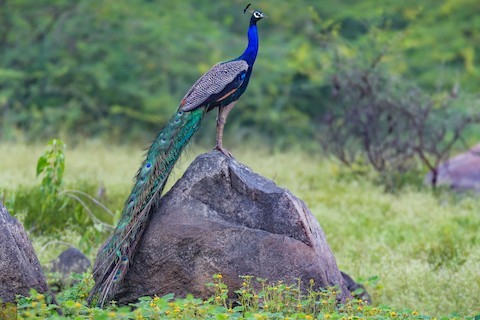
Indian Peafowl, male. (Osman Sagar Lake, Rangareddy, Telangana, India; September 12, 2019.) © Manjula Desai
The wings are heavily barred black-and-white, except the primaries, which are pale-copper.

Indian Peafowl, male showing its luxuriant tail and coppery primaries. (Bundala National Park, Sri Lanka; February 25, 2016.) © Nancy Cox
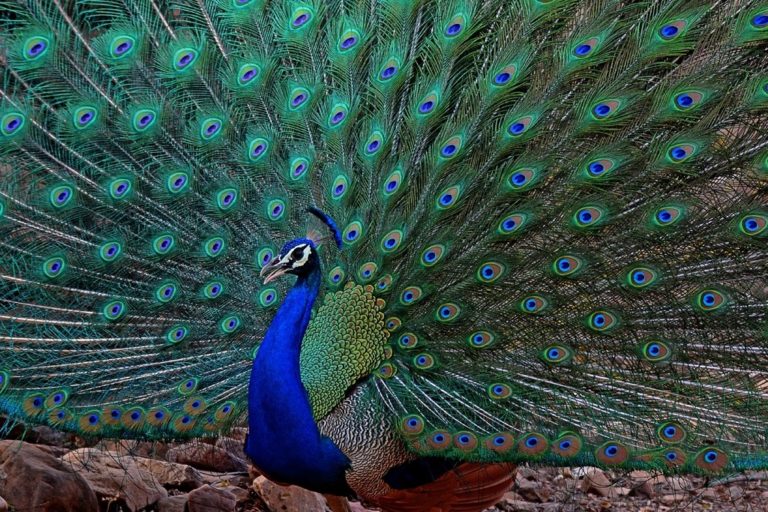
Indian Peafowl, male displaying. (Ranthambore National Park, Rajasthan, India; May 26, 2015.) © Yuwaraj Gurjar
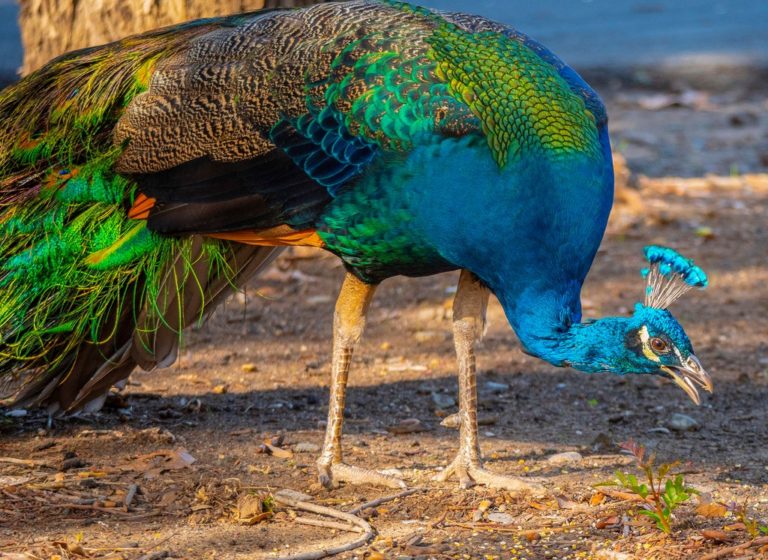
Indian Peafowl, male showing maximum iridescence. (Anaheim, California; December 20, 2018.) © uzun
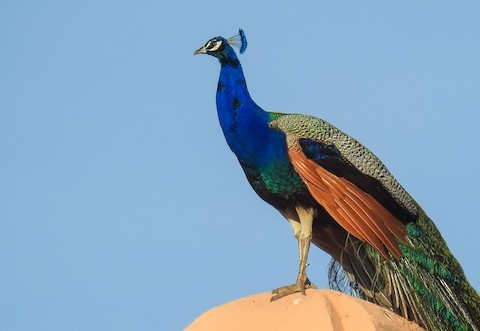
Indian Peafowl, male showing its coppery primaries. (Los Angeles, California; April 22, 2017.) © Tracy Drake
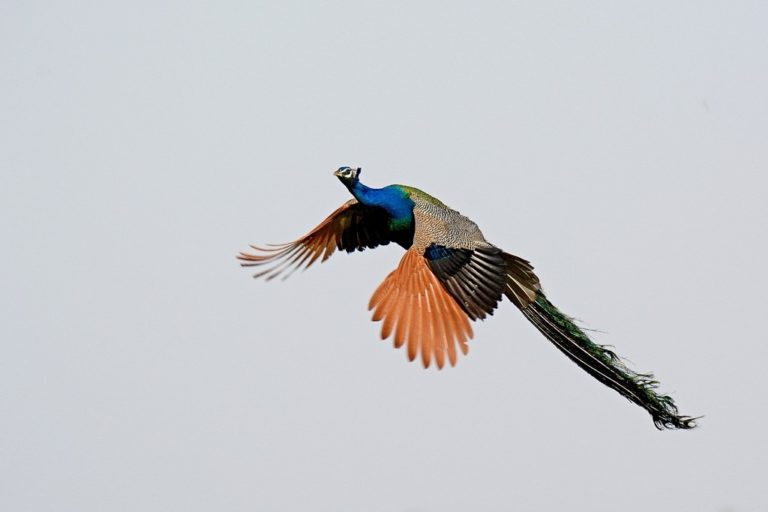
Indian Peafowl, male in flight showing coppery primaries. (Ranthambore National Park, Rajasthan, India; May 24, 2015.) © Yuwaraj Gurjar
The male has a crest of blue feathers with bare shafts that fan out from the top of the skull, somewhat like a bouquet. Its head is dark-blue (but often appears black at a distance) with two white diagonal streaks and a dark streak across the eye.
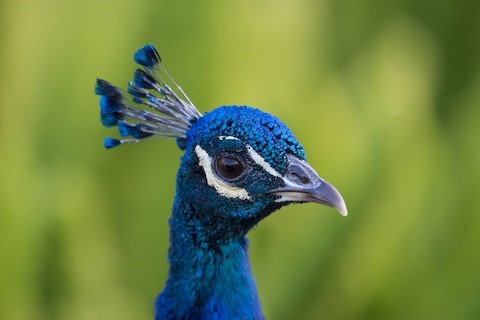
Indian Peafowl, male, close-up view of head showing details of crest and facial pattern. (Los Angeles County Arboretum & Botanic Garden, Los Angeles, California; November 5, 2016.) © Adam Jackson

Indian Peafowl, male displaying and showing details of head plumage, golden-green back, and eye-spots on tail feathers (i.e., uppertail coverts). (Spanish Manor, Pinellas County, Florida; February 1, 2019.) © Bruce Cochrane
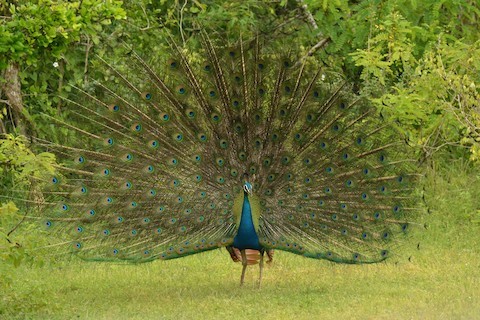
Indian Peafowl, male displaying. (Yala National Park, Sri Lanka; January 7, 2016.) © Ronald de Mol

Indian Peafowl, side-view of male displaying. (Uda Walawe National Park, Sri Lanka; January 20, 2011.) © Christoph Moning

Indian Peafowl, male displaying. (Los Angeles County Arboretum & Botanic Garden, Los Angeles, California; March 5, 2020.) © Andrew Emlen
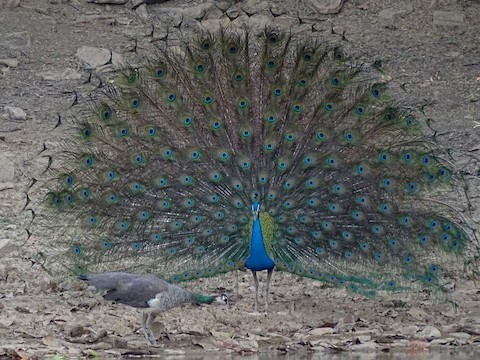
Indian Peafowl, male displaying to female. (Kutch District, Gujarat, India; April 30, 2015.) © Shantilal Varu
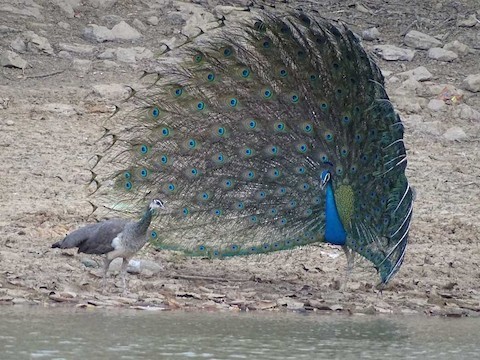
Indian Peafowl, male displaying to female. (Kutch District, Gujarat, India; April 30, 2015.) © Shantilal Varu
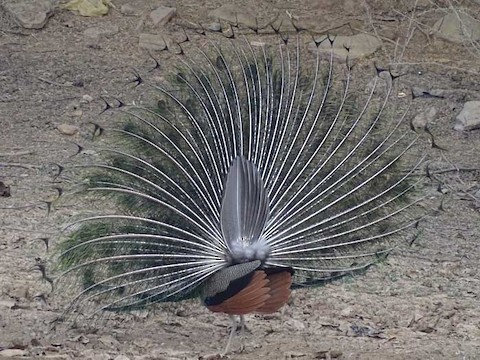
Indian Peafowl, posterior view of male displaying. (Kutch District, Gujarat, India; April 30, 2015.) © Shantilal Varu
The female has largely brown upperparts, and white underparts. It has a brown crown with a crest much like the male’s, but brown instead of blue. The face and throat are mostly white with a dark streak across the eye.
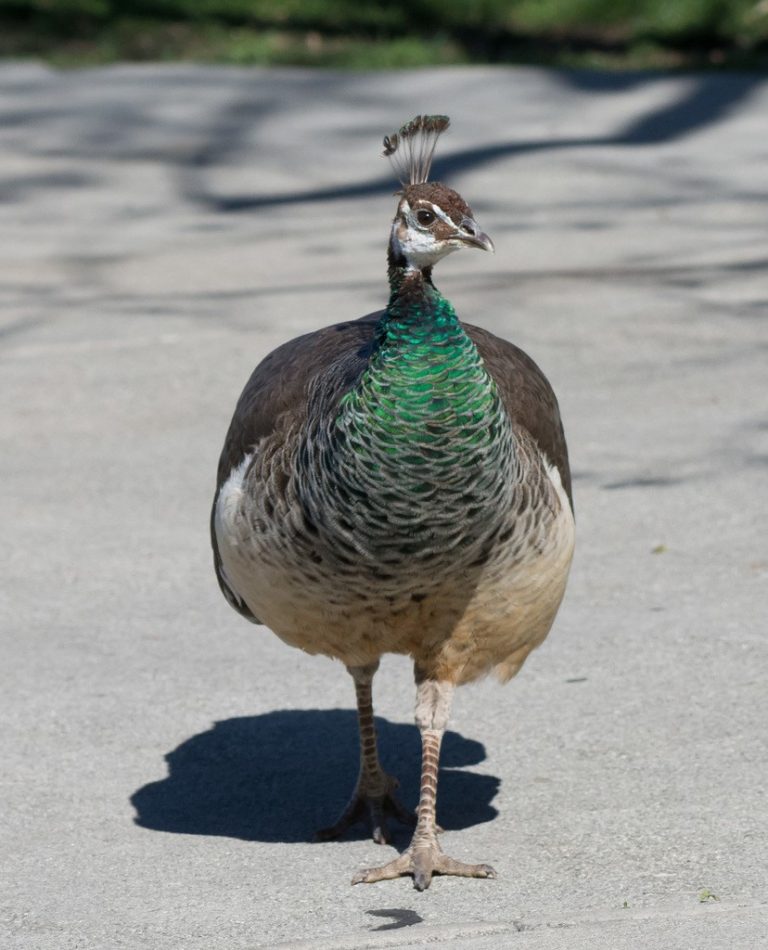
Indian Peafowl, female. (Arcadia, California; February 13, 2017.) © Gordon Karre

Indian Peafowl, female. (Shendurney Wildlife Division, Thenmala, India; March 1, 2015.) © Firos AK
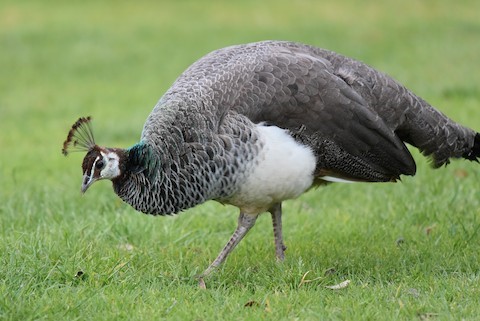
Indian Peafowl, female. (Shakespeare Regional Park, Rodney District, Auckland, New Zealand; September 27, 2019.) © Bruce Wedderburn
The female’s neck is mostly blackish-brown with green iridescence, strongest near the head, and becoming progressively duller and scaled with pale-brown toward the upper breast.
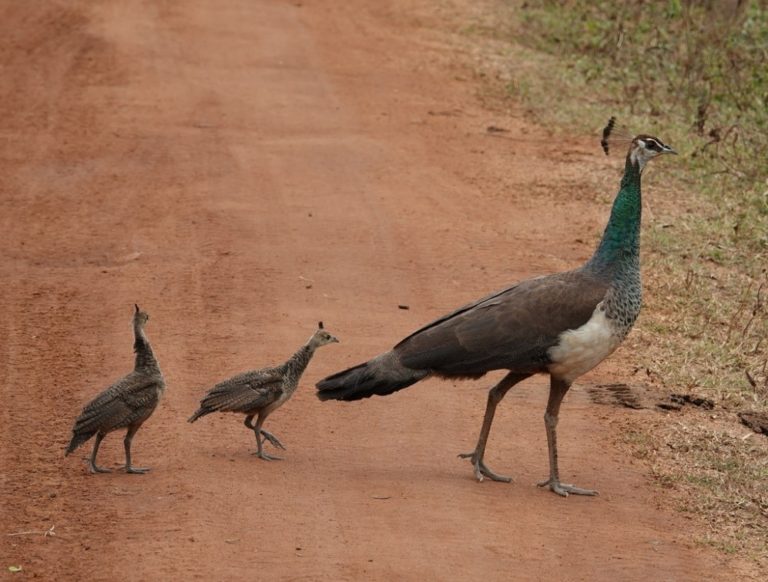
Indian Peafowl, female with two chicks. (Yala National Park, Sri Lanka; February 4, 2019.) © Matthew Blissett
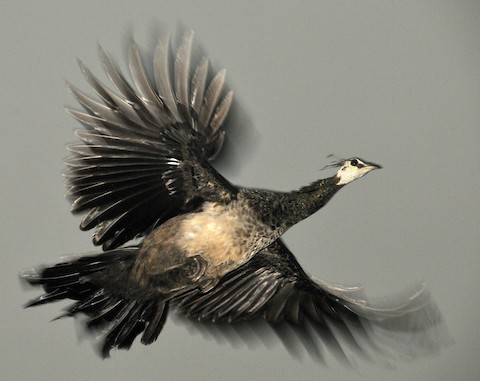
Indian Peafowl, female in flight. (Keoladeo Ghana National Park, Bharatpur, Rajasthan, India; November 24, 2010.) © Tomas Grim

Indian Peafowl, female, dorsal view. (Nelliyampathy Ghat Road, Palakkad, Kerala, India; February 5, 2017.) © Mathew Thekkethala

Indian Peafowl, female, dorsal view. (Ranthambore National Park, Rajasthan, India; March 29, 2018.) © dushenkov
Notes
Monotypic species.
References
BirdLife International. 2016. Pavo cristatus. The IUCN Red List of Threatened Species 2016: e.T22679435A92814454. https://dx.doi.org/10.2305/IUCN.UK.2016-3.RLTS.T22679435A92814454.en. (Accessed March 13, 2020.)
eBird. 2020. eBird: An online database of bird distribution and abundance. Cornell Lab of Ornithology, Ithaca, N.Y. http://www.ebird.org. (Accessed March 13, 2020.)
Madge, S., and P.J.K. McGowan. 2002. Pheasants, Partridges, and Grouse: A Guide to the Pheasants, Partridges, Quails, Grouse, Guineafowl, Buttonquails, and Sandgrouse of the World. Princeton University Press, Princeton, N.J.
McGowan, P.J.K., G.M. Kirwan, and P. Boesman. 2020. Indian Peafowl (Pavo cristatus). In: del Hoyo, J., Elliott, A., Sargatal, J., Christie, D.A. & de Juana, E. (eds.). Handbook of the Birds of the World Alive. Lynx Edicions, Barcelona. https://www.hbw.com/node/53521. (Accessed March 13, 2020.)
Pyle, R.L., and P. Pyle. 2017. The Birds of the Hawaiian Islands: Occurrence, History, Distribution, and Status. Version 2 (January 1, 2017). http://hbs.bishopmuseum.org/birds/rlp-monograph/. B.P. Bishop Museum, Honolulu, Hawaii.
Xeno-Canto. 2020. Indian Peafowl – Pavo cristatus. https://www.xeno-canto.org/species/Pavo-cristatus. (Accessed March 13, 2020.)
